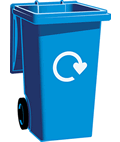
What happens to the contents of my blue wheelie bin after collection?
We collect recycling separately, card and paper in a blue bag and plastic bottles, tubs, trays, tins, cans and glass items in a blue bin. The blue bag contents don’t have to be sorted but the blue bin contents go to a state of the art recycling facility in Aldridge, West Midlands where they are mechanically sorted.
- How is the recycling sorted?
-
The householder plays an important role in this process as they are the first link in the chain that turns household waste into usable resources. It is therefore very important that at this first stage the right items/materials are put into the recycling bin.
If the wrong items/materials, such as; food waste, nappies, garden waste or cat litter, are put into the blue recycling bin this could spoil/contaminate the other "target" materials and the whole load could be rejected.
How does the plant sort the materials?
After the recyclable materials have been tipped onto the tipping floor they are scooped up and placed onto a conveyor belt. As the conveyor belt travels through the plant, different technologies are used to remove each recyclable material. See below for a brief description of how each material is removed from the belt.
- Paper and cardboard
-
 PAPER & CARDBOARD: These items no longer need to be sorted as they are collected separately from other recyclable items.
PAPER & CARDBOARD: These items no longer need to be sorted as they are collected separately from other recyclable items. - Glass bottles and Jars
-
 By the time the glass bottles and jars have reached the recycling plant they are broken up and the glass is simply sieved out and taken away by another conveyor belt.
By the time the glass bottles and jars have reached the recycling plant they are broken up and the glass is simply sieved out and taken away by another conveyor belt. - Steel and Aluminium cans
-
 STEEL CANS: These are removed by a large magnet as the conveyor belt travels under it.
STEEL CANS: These are removed by a large magnet as the conveyor belt travels under it.ALUMINIUM CANS: These are removed by an electric charge that is fired across the belt. This throws the cans off the belt onto another.
- Plastic bottles and tubs
-
 PLASTICS: Each type of plastic reflects light at a different wavelength. As the plastics travel along the belt a scanner is set to recognise each plastic by its light signature. A scanner is set to recognise PET type 1 plastic (clear pop bottles). When the scanner detects one it fires it off the belt with an air jet onto another.
PLASTICS: Each type of plastic reflects light at a different wavelength. As the plastics travel along the belt a scanner is set to recognise each plastic by its light signature. A scanner is set to recognise PET type 1 plastic (clear pop bottles). When the scanner detects one it fires it off the belt with an air jet onto another.This is done for the 4 main types of plastics that are collected: PET, HDPE, PVC & PP5. Below is a download listing these identification codes and which type of plastic we accept.
At the end of each conveyor the material is bailed up ready to be delivered to companies that use the material to manufacture new products etc
plastic identification codes.pdf (43.83 KB)
